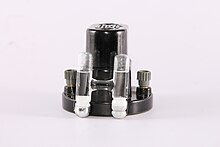Weston cell



TheWeston cellorWeston standard cellis awet-chemical cellthat produces a highly stablevoltagesuitable as a laboratory standard forcalibrationofvoltmeters.Invented byEdward Westonin 1893, it was adopted as the International Standard forEMFfrom 1911 until superseded by theJosephson voltage standardin 1990.
Chemistry
[edit]Theanodeis anamalgamofcadmiumwithmercurywith acathodeof pure mercury over which a paste of mercurous sulfate and mercury is placed. Theelectrolyteis asaturated solutionofcadmium sulfate,and thedepolarizeris a paste ofmercurous sulfate.
As shown in the illustration, the cell is set up in an H-shaped glass vessel with the cadmium amalgam in one leg and the pure mercury in the other. Electrical connections to the cadmium amalgam and the mercury are made byplatinumwires fused through the lower ends of the legs.
- Anode reaction
- Cd(s) → Cd2+(aq) + 2e−
- Cathode reaction
- (Hg+)2SO2−
4(s) + 2e−→ 2Hg(l) +SO2−
4(aq)
Reference cells must be applied in such a way that no current is drawn from them.
Characteristics
[edit]The original design was a saturated cadmium cell producing a1.018638Vreference and had the advantage of having a lowertemperature coefficientthan the previously usedClark cell.[1]
One of the great advantages of the Weston normal cell is its small change of electromotive force with change of temperature. At any temperaturetbetween0 °Cand40 °C,
- Et/V =E20/V −0.0000406(t/°C − 20) −0.00000095(t/°C − 20)2+0.00000001(t/°C − 20)3.
This temperature formula was adopted by the London conference of 1908[2]
The temperature coefficient can be reduced by shifting to an unsaturated design, the predominant type today. However, an unsaturated cell's output decreases by some 80 microvolts per year, which is compensated by periodic calibration against a saturated cell.
See also
[edit]References
[edit]- ^Robert B. NorthropIntroduction to instrumentation and measurements 2nd edCRC Press, 2005ISBN0-8493-3773-9page 14
- ^"Electric units and standards".Circular of the National Bureau of Standards.1916(58). Washington, D.C.: USA Government Printing Office: 39. 25 September 1916.Retrieved12 July2016.
Literature
[edit]- Practical Electricityby W. E. Ayrton and T. Mather, published by Cassell and Company, London, 1911, pp 198–203
- U.S. patent 494,827,"Voltaic cell"
- Standard Cells, Their Construction, Maintenance, and Characteristicsby Walter J. Hamer, National Bureau of Standards Monograph 84, January 15, 1965.

